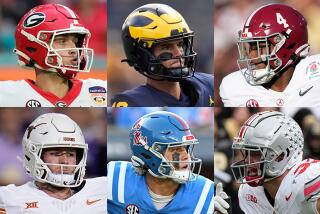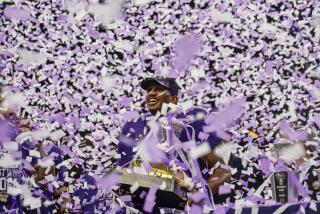Louisiana State is No. 1 in BCS — and don’t gripe
- Share via
What a “shock” it was that the Southeastern Conference had the No. 1 team in Sunday’s first release of the Bowl Championship Series standings.
You were expecting the Sun Belt?
The SEC has won five straight BCS national titles and seven of the 13 played.
It wasn’t even a surprise, in fact, that the SEC opened with the top two schools.
There can be no gripe about Louisiana State leading the way. The Tigers are 7-0 with nonconference wins over BCS No. 10 Oregon and No. 15 West Virginia.
LSU earned a BCS average of .9522 and is followed by SEC teammate Alabama at .9519.
Big 12 fans probably don’t have to worry Oklahoma (.9301) and Oklahoma State (.8568) are third and fourth since LSU plays at Alabama on Nov. 5
That could leave the second title-game spot to the winner of Oklahoma at Oklahoma State on Dec. 3.
Boise State, which debuted at No. 5, is going to need help to reach the title game, as the Broncos are surrounded by undefeated teams that will have better resumes if they keep winning.
Rounding out the BCS top 10 are Wisconsin, Clemson, Stanford, Arkansas and Oregon.
Wisconsin is No. 4 in both polls used in the BCS formula but is being dragged down by a No. 11 computer average.
Stanford has blown out six opponents and has a 14-game winning streak but is only No. 8 in the BCS computers. Stanford, however, plays Washington, USC and Oregon in the coming weeks.
Kansas State, one of this year’s surprise teams at 6-0, is No. 11 in the first BCS standings but soon faces a brutal stretch against Oklahoma, Oklahoma State, Texas A&M and Texas.
The BCS rankings system, some would say, was introduced in 1998 as a means to torture, infuriate and confound college football followers.
It was actually intended to pair two schools for a “national title” while preserving the decades-old bowl system in a sport that has staunchly opposed a more traditional playoff format.
Has it worked?
Before 1998, national champions were crowned independently by the Associated Press and coaches’ polls. Starting in 1998, the Rose Bowl agreed to release the Pacific 10 Conference and/or Big Ten Conference champion to a title game if they finished No. 1 or No. 2 in a rankings system that incorporated polls and a computer component.
The BCS standings have been tweaked and prodded over the years. The AP pulled out after a 2004 voting controversy involving California and Texas. The Harris Poll, in 2005, replaced the AP, which has crowned independent champions since 1936.
Whether you hate or just loathe it, the BCS has provided more access for schools that would have otherwise not been eligible for major bowls such as the Rose, Fiesta, Sugar and Orange.
Texas Christian, last year’s Rose Bowl champion, could not have played in the game before 1998.
The BCS has also brought more clarity to college football’s controversial postseason.
Before 1998, because of bowl contracts, the No. 1 and No. 2 schools met only 11 times in a bowl between 1936 and 1998.
The BCS has also been savagely attacked while threats of antitrust lawsuits have loomed almost since inception.
There have been major controversies.
In 2001, Oregon finished No. 2 in both polls but No. 4 in the BCS standings.
Nebraska earned the bid to play Miami that year over Colorado, which beat Nebraska, 62-36.
In 2003, USC was No. 1 in both polls but finished No. 3 in the final BCS standings behind Oklahoma and Louisiana State.
LSU defeated Oklahoma in the Sugar Bowl to win the BCS title that year, but the AP crowned USC its national champion.
“Everyone loves to talk about our standings, and that’s one reason why college football’s regular season is so exciting,” BCS Executive Director Bill Hancock said in a statement attached to the first standings.
Well, that’s one way of looking at it.
Weekend wrap
— Stanford keeps rolling: The Cardinal led at Washington State by only 10-7 at halftime, but it pulled away to an easy 44-14 victory. Stanford has won 14 straight games by an average of 28.8 points. The Cardinal’s closest game since a 17-13 victory against Arizona State last Nov. 13 was a 26-point win over UCLA on Oct. 1.
— They’re really “Fab”: The top four quarterbacks in this week’s NCAA pass efficiency ratings — Russell Wilson (Wisconsin), Robert Griffin III (Baylor), Andrew Luck (Stanford) and Kellen Moore (Boise State) — have all completed more than 70% of their passes while combining for 75 touchdowns against only 10 interceptions.
— CBSSports.com notes Oklahoma State is 40-14 since Coach Mike Gundy went on his now-famous “I’m a man, I’m 40!” rant after a 2007 game. The YouTube video has received 2.2 million views.
— Sark Attack: Washington, which finished 0-12 only three seasons ago, is 5-1 and cracked the top 25 in the Associated Press poll (No. 22) and USA Today coaches’ index (No. 24). It is the first time the Huskies have been ranked in both polls the same week since 2003.
— Oklahoma’s 47-17 win at Kansas was tougher than it should have been. The Sooners struggled in the red zone and led by only 10 points at halftime. Quarterback Landry Jones finished with 19 incomplete passes against the nation’s worst defense. After giving up 17 first-half points, though, Oklahoma’s defense held Kansas to six second-half yards and one first down.
— Quote book: “Hey, will you just shut up?” That’s what Oregon Coach Chip Kelly screamed at an obnoxious Oregon fan on live television while Kelly was being interviewed by ESPN’s Erin Andrews after the Ducks’ victory against Arizona State on Saturday night.
twitter.com/dufresnelatimes
More to Read
Go beyond the scoreboard
Get the latest on L.A.'s teams in the daily Sports Report newsletter.
You may occasionally receive promotional content from the Los Angeles Times.











